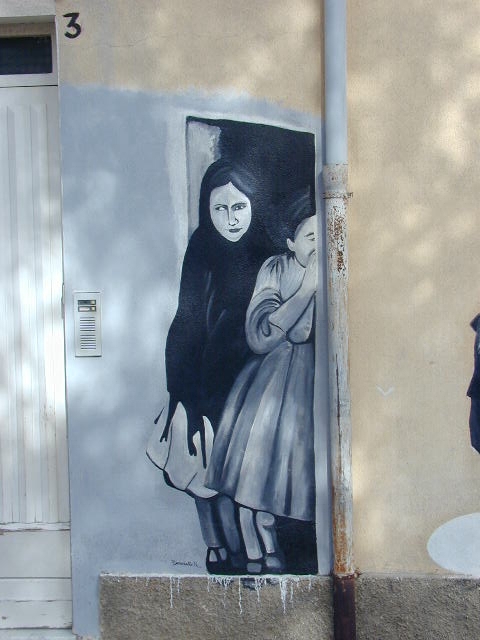zurück

Mujer Frauen Murales Wandgemälde in Orgosolo Sardinien Wallpictures
Orgosolo Sardinia alt + jung
Murales in
Sardinia are a captivating part of the island's
cultural landscape. Sardinia is
home to vibrant and often thought-provoking murals, which can be found in
different regions of the island. These murals range from traditional folk art to
contemporary political statements, and they are a significant part of Sardinia’s
identity. Here are some of the most notable places and aspects of
murales in Sardinia:
1.
Orgosolo (Famous Murals Village):
-
Orgosolo is the most famous town in Sardinia for its murals.
Located in the Barbagia
region, in the central mountains of
Sardinia, this town is often referred to as the “village
of murals” due to the large number of painted walls throughout the
town.
- The murals in
Orgosolo date back to the
1960s when the first
political murals appeared, reflecting the social and political unrest of the
time, particularly related to Sardinian
independence and
autonomy.
- Over time, the murals evolved to cover
a wide range of themes, including
historical events, social
issues, Sardinian
traditions, environmental
concerns, and political
movements.
- Walking through the streets of
Orgosolo is like strolling through an open-air art gallery. Famous murals
include depictions of Sardinian
heritage, indigenous
struggles, local folklore,
and even international politics.
Notable Murals in Orgosolo:
-
Sardinian independence
symbols, such as the flag of
Sardinia.
-
Political protests
against colonialism and fascism.
-
Images of revolutionary figures
and local heroes.
-
Environmental themes
addressing the preservation of the Sardinian landscape and wildlife.
2.
Villagrande Strisaili:
- Located in the
Ogliastra region, this
village is another hub of traditional murals. In
Villagrande Strisaili,
murals tell stories of Sardinian
daily life, farming,
and family life in the
mountains.
- The murals here have a strong
connection to the Sardinian
identity and are often more focused on
agriculture,
nature, and
community spirit,
reflecting the life of the village.
3.
Santu Lussurgiu:
- Another example of Sardinian villages
that embrace mural art is Santu
Lussurgiu in the province
of Oristano. The murals here tend to depict scenes from
Sardinian folklore, the
landscape, and
historical events.
- These murals are a tribute to the
village's rural life, as well as representations of
local traditions and
historical figures.
4.
Cagliari:
- While the famous murals are more
concentrated in the central and northern parts of Sardinia,
Cagliari, the island's
capital, also has some street art and murals, especially in its
historic districts like
Stampace and
Marina.
- Cagliari has witnessed the emergence
of modern urban street art,
with some murals on buildings
and walls depicting
social issues,
abstract art, and
Sardinian heritage. The
murals here often engage with the themes of
urbanization,
youth culture, and
identity.
5.
Alghero:
-
Alghero, a coastal town
in Northwest Sardinia, is
known for its Catalan heritage,
and murals in this town sometimes celebrate the
Catalan culture and
language.
- Some murals reflect the
seafaring traditions of
the area, with vibrant depictions of
maritime life,
fishing, and the
relationship between locals and
the sea.
6.
Murals in the Supramonte Region:
- The
Supramonte region,
located in central Sardinia, also has some murals painted by local artists
and communities. These murals tend to be smaller, but they reflect the
mountainous culture of
the area, focusing on themes such as
mountain life,
nature, and
Sardinian heritage.
7.
Contemporary Murals:
- In addition to the historical and
political murals, Sardinia has seen the rise of
contemporary street art
in urban centers like Olbia,
Nuoro, and
Sassari. These murals are
often less political and more focused on
modern artistic expression,
urban culture, and
abstract art.
-
Murals festivals have
also become popular in recent years, where artists from around the world are
invited to create large-scale works on building walls. One such event is
“Murals in the Streets”
festival, which is held periodically and involves local and international
artists.
8.
Murales as Cultural Heritage:
- The
murales in Sardinia
represent much more than just art. They are an integral part of the island’s
cultural and social heritage,
reflecting the identity,
struggles, and
aspirations of the
Sardinian people. The murals of towns like
Orgosolo have become
iconic representations of the island’s
political history, while
other villages have murals that highlight the importance of
Sardinian traditions and
agriculture.
Key Takeaways:
-
Orgosolo is the most
famous Sardinian town for murals, with a rich tradition of
political and social commentary.
- Murals in other towns, such as
Villagrande Strisaili and
Santu Lussurgiu, often
focus on Sardinian folklore,
rural life, and
traditions.
-
Urban centers like Cagliari
and Sassari have seen the
rise of contemporary street art
and modern murals.
-
Murals in Sardinia are an
expression of local identity,
and they offer visitors a unique insight into the
history,
culture, and
values of the island.
Best Time to Visit:
- The
spring and
autumn are the best times
to explore the murals of Sardinia as the weather is mild and comfortable for
walking tours through the towns.
 26.07.25 Copyright Dirk
Rauschenbach Koelnerstrasse 293 51702 Bergneustadt
Datenschutzerklaerung 02261 9788972 Mail ccooly(
at) web.de
26.07.25 Copyright Dirk
Rauschenbach Koelnerstrasse 293 51702 Bergneustadt
Datenschutzerklaerung 02261 9788972 Mail ccooly(
at) web.de
 Safaris
Bergsteigen
Wandern
Inselwandern Weltweit
Safaris
Bergsteigen
Wandern
Inselwandern Weltweit
 Europa
Inselwandern
Europa
Inselwandern
 Städtewandern
Städtewandern
 Paintings
Paintings Dirk Rauschenbach
Dirk Rauschenbach
 Safaris
Bergsteigen
Wandern
Inselwandern Weltweit
Safaris
Bergsteigen
Wandern
Inselwandern Weltweit
 Europa
Inselwandern
Europa
Inselwandern
 Städtewandern
Städtewandern
 Paintings
Paintings Dirk Rauschenbach
Dirk Rauschenbach

![]() 26.07.25 Copyright Dirk
Rauschenbach Koelnerstrasse 293 51702 Bergneustadt
Datenschutzerklaerung 02261 9788972 Mail ccooly(
at) web.de
26.07.25 Copyright Dirk
Rauschenbach Koelnerstrasse 293 51702 Bergneustadt
Datenschutzerklaerung 02261 9788972 Mail ccooly(
at) web.de